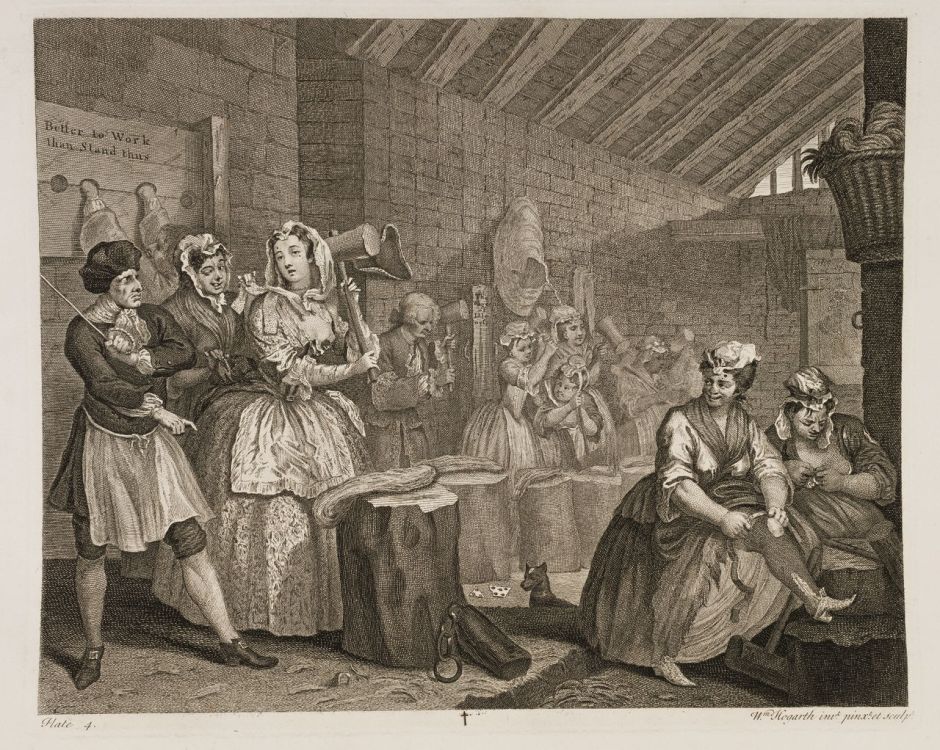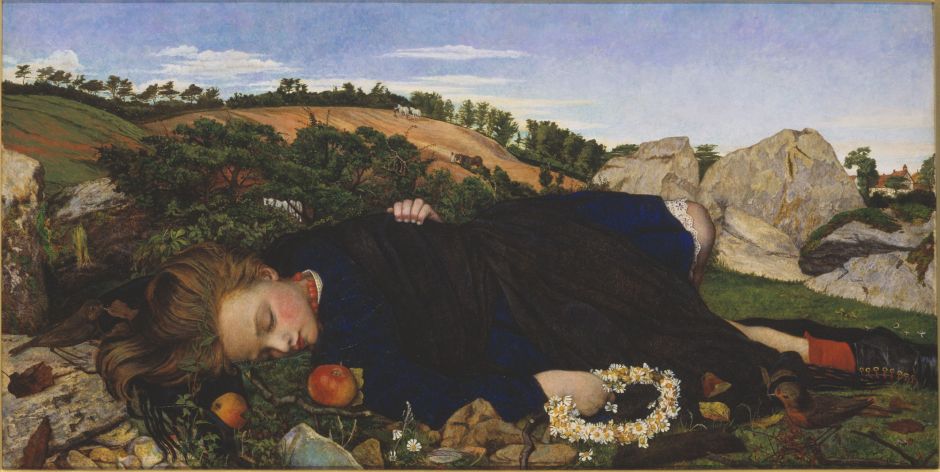In the nineteenth century several narratives became popular themes in literature and painting, among them that of the ‘fallen woman’. This weekend, as part of my occasional series examining narratives centred on women, I look at a selection of paintings telling this story. This article covers the descent down the slope of moral failure, and tomorrow’s considers the possibility of redemption, and eventual outcome.
The fallen woman has her roots in the Judaeo-Christian story of Eve and the fall of man, as expressed in the book of Genesis, and much later in John Milton’s Paradise Lost.

It was perhaps William Blake’s Satan Exulting over Eve that first depicted Eve’s dream of Satan giving her the fateful apple, and sweeping her up into the cloud before she sinks down and falls asleep.
The first full-length visual account of a fallen woman was probably that given in William Hogarth’s first serial story A Harlot’s Progress. Its six paintings were completed in 1731, and appeared in engravings in 1732. Tragically all the paintings were destroyed by fire when at Fonthill House in 1755, so we only have prints from which to study Hogarth’s first painted narrative series.
The general outline of the story is of an innocent country girl, Moll Hackabout, who comes to London, and immediately falls into the hands of a notorious brothel-keeper and madame. Moll becomes the kept mistress of a wealthy merchant, but later slides into common prostitution. She is arrested, and ends up in London’s Bridewell Prison. Having contracted syphilis earlier, the disease progresses, steadily killing her. She finally dies at the age of 23, mourned only by her fellow prostitutes.

Moll Hackabout is first shown arriving at the Bell Inn, Cheapside. Her clothing, with a fine bonnet, white dress, and flower adornments, shows her to be an innocent country girl, but she is here being inspected by Elizabeth Needham, a notorious brothel-keeper and madame. Hogarth gives the latter black skin lesions intended to signal that she has longstanding sexually-transmitted disease (syphilis), and her face is aged.
In the doorway at the right is an equally notorious rake, Colonel Francis Charteris, and his pimp John Gourlay, who are also taking an interest in the arrival of a fresh young innocent. In Moll’s luggage is a symbolic dead goose, suggesting her death as a result of gullibility. The address on a label attached to the dead goose reads “My lofing cosen in Tems Stret in London”, suggesting that Moll’s move to London has been arranged through intermediaries, who may well have profited from her being trafficked into the hands of Elizabeth Needham.
Behind Moll, an itinerant preacher is engrossed in spreading the message to his small ad hoc congregation in the back of a covered wagon. In front of that a pile of pots is just about to collapse, as is Moll’s life.

Hogarth next shows us Moll at the top of the slippery slope to perdition, as the kept woman or mistress of a wealthy Jewish merchant; sadly anti-semitism was endemic at the time. The cues to this are abundant, in Old Testament paintings on the wall, which also seem to prophesy Moll’s fate at his hands. Enjoying relative luxury at this stage, she has a black serving boy and a monkey. On a dressing table at the far left is a mask, for masquerade balls, and Moll has just deliberately knocked the table over to distract her merchant’s attention, while in the background another lover is able to tiptoe out.

Moll’s descent continues as she is here nothing but a common prostitute, her bed being the only substantial piece of furniture in the room. Her maid is already floridly syphilitic, with black pox marks on her face and a sunken bridge to her nose. She keeps a cat, who is posed in the manner of her mistress when at work. She’s surrounded by symbols of her evil, such as the black witches hat and broomstick, and above the bed is a wigbox belonging to a highwayman who was hanged on 11 May 1730. At the right, in the background, Sir John Gonson, a famous magistrate, is entering with three armed bailiffs to make her arrest. Meanwhile she is showing off a new and expensive pocket watch.

Moll ends up in Bridewell Prison, beating hemp to make nooses for hanging. Her jailer, at the extreme left, beats her to make her work harder, while his wife is stealing the clothes off her back. To the right of Moll is a card-sharp who is accompanied by his dog, and possibly the rest of his family. In the background is a black woman who appears pregnant, who could therefore not be executed or transported. In the foreground, at the right, is Moll’s maid, showing off a pair of Moll’s shoes. Moll herself now has growing black spots on her face, indicating the progress of her own syphilis.

With Moll in the final throes of her syphilis, she’s attended by Dr. Richard Rock (dark hair) and Dr. Jean Misaubin (white hair), who are arguing over the best treatment. Another woman, possibly her landlady, is rifling through Moll’s possessions, while her young son sits close to the fire. A Passover cake is hung by the door as a flytrap, suggesting that her former lover, the Jewish merchant, may be supporting her in her dying days.

Moll finally dies at the age of 23, on 2 September 1731, and her wake is attended mainly by fellow prostitutes. A parson sits, drunkenly fondling the woman next to him, and spilling his brandy, a sexually explicit symbol. Most of the women bear the hallmarks of syphilis, and Moll’s orphaned son sits innocently playing under her coffin.
Moll’s rural origins were echoed repeatedly in later accounts.

John Roddam Spencer Stanhope’s Robin of Modern Times (1860) is a highly original wide-angle composition, and one of the most visually arresting paintings made at this time. It’s set in the rolling countryside of southern England, during the summer.
The foreground is filled with a young woman, who is asleep on a grassy bank, her legs akimbo. She wears cheap, bright red beads strung on a necklace, and a floral crown fashioned from daisies is in her right hand. She wears a deep blue dress, with a black cape over it, and the white lace of her petticoat appears just above her left knee. On her feet are bright red socks and black working/walking boots. A couple of small birds are by her, one a red-breasted robin, and there are two rosy apples near her face. In the middle distance, behind the woman’s head, white washing hangs to dry in a small copse. A farm labourer is working with horses in a field, and at the right is a distant farmhouse.
This most probably refers to the popular contemporary account of how girls and young women from the country around London found their way to the city to become its prostitutes.

For Christian Krohg in Oslo, young women came to the city to work as seamstresses, who then ended up as prostitutes. The young woman seen in his Tired from 1885 is one of many thousands who worked at home at that time, toiling for long hours by lamplight for a pittance. At the left is an empty cup, which had probably contained the coffee she drank to try to stay awake at her work.
The paltry income generated by sewing quickly proved insufficient for those women who then sought alternatives. Prostitution had officially become a criminal offence in Norway in 1842, but was tolerated in Oslo (then known as Kristiania) from 1840, with the introduction of police and medical supervision of women sex-workers.

In 1883, Krohg painted Madeleine, the first of his long series of works documenting this descent.

In his Seamstress’s Christmas Eve from 1921, a young woman is in her garret bed-sit, where she has been toiling long hours at her sewing machine. An affluent couple, a relative or employer perhaps, has just arrived to give the young woman a Christmas tree, a large wicker basket of presents, and more. Maybe that young woman can still be saved from the fate brought on by the sewing machine.

